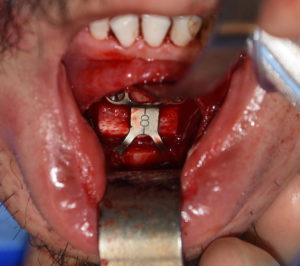Chin augmentation is a multi-dimensional procedure. While most chin enhancements are for horizontal movements, there is a small subset of people who need vertical lengthening only or a combination of vertical and horizontal increases. When the chin is short in height, the distance between the lower lip and the bottom of the chin is small. Careful inspection will reveal that the lower lip looks is slightly folded over, the crease below the lip (labiomental crease) is deep, and the chin looks small even though it may have good projection.
Vertical chin lengthening can be done by either an implants or actually lengthening the bone. Both can be effective but patient selection is critical.
Minor amounts of chin lengthening can be done with an implant. But the implant must be placed off the front edge, oriented more downward than normal. Because of this positioning on the ledge, so to speak, it is important that it be screwed into place. When an implant is placed in this position, I always use two screws spaced as far apart and as far back as the incision length will permit. To not have the increased chin length look too narrow, an extended or more wrap around chin implant style is used.
It is also possible to make a custom chin/jaw implant that is designed off of a computer model to make for vertical lengthening done completely by an implant….and it can be quite significant. In my Indianapolis plastic surgery practice, I have done this a handful of times but the motivation to custom make such an implant needs to be considerable given the increased expenses to do so. Such ‘motivation’ should be that the change wanted in the chin or jaw shape could not more easily be obtained by a bone procedure. (e.g., vertical lengthening of the jaw from one angle to the other)

Vertical lengthening of the chin increases lower facial height to make for a more balanced face. It also makes the labiomental crease more shallow and often improves the neck angle as well.
Dr. Barry Eppley
Indianapolis, Indiana


